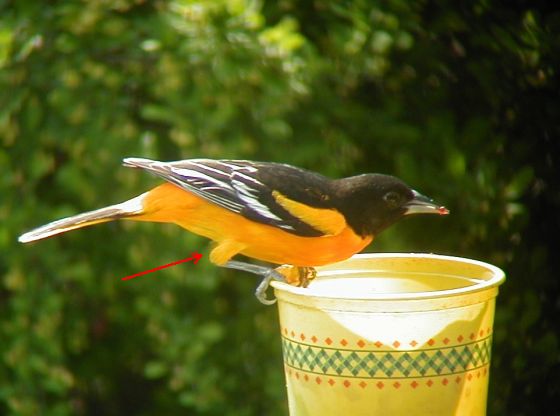
Marcy Cunkelman’s Baltimore oriole agreed to return for a cameo appearance to illustrate another anatomy lesson.
Last week I pointed out that the part of the bird we call the “leg” is actually its foot. The tibia is where its real leg begins.
In songbirds the tibia is feathered and usually unseen, hidden among the belly feathers. Here, Marcy’s oriole is showing his tibia as he perches on her jelly dish. What a surprise that his leg is orange!
In long-legged wading birds the tibia is naked and quite obvious because they need the tibia’s length to keep their bodies above the water.
We have tibias, too. They’re the larger and stronger of the two bones between our feet and knees. Above our knees the bone is called the femur.
Birds have femurs but good luck trying to see them. We’re lucky to see the tibia!
(photo by Marcy Cunkelman)
I love this site and this is a pretty bird with a nice lesson.
I want to share this with my family on a web site, I think they will love it.
So I’m sending them a link…
I never knew the bird’s tibia was up so high! Do they also have a fibula in there? BTW, I bet most folks’ familiarity with bird tibiae, fibulae, and femora comes in the form of “drumsticks and thighs!”
Dear Kate–Your mention of naked tibiae on “long-legged wading birds” was my cue to post my observation here. Wed., after I had my hair cut on Butler St. in Lawrenceville (Platinum opposite Allegheny Cemetery) I looked up and saw a large-winged bird with what seemed to be an enormously long tail dragging itself to a possible wind draft to lift him/her higher. As I looked on, I realized the “tail” was its feet, dangling behind. I believe it was a great blue heron, leaving the cemetery for the river. I’ve seen them in FL, so am relatively sure that is what I saw, and I’ve read they are in the area, but in the CITY? I’ve seen all sort of critters in the cemetery, from deer (15 at a time, once) to wild turkeys, ducks, Canada geese, etc., but never a heron. Do you think they hunt frogs in the ponds there, or chipmunks (everywhere!) and then roost near the river? It was awesome!
Anne
It’s very cool that great blue herons come into the city to hunt. They have nesting sites along the river and travel up to 30 miles to hunt for their nestlings whom they feed by regurgitation. Thanks for reporting this sighting.